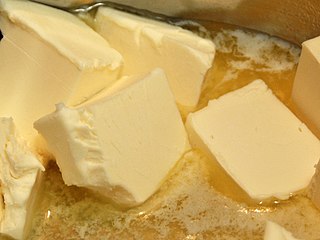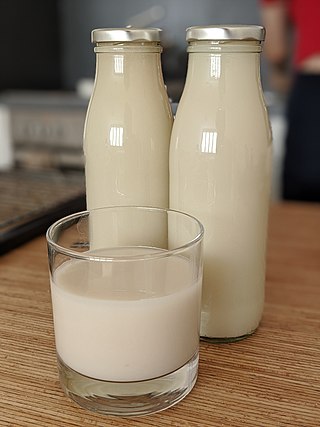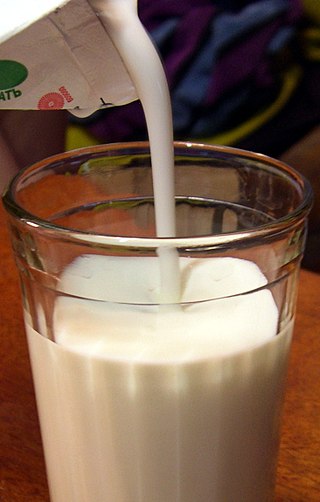Carbonated milk or soda milk is a carbonated soft drink. It can be made from powdered milk or fresh milk, and often has added flavor. In addition to modified mouth feel, carbonated milk also has a longer shelf-life than similarly processed flat milk and a different flavor. It is sold by several companies and is most popular in Asia.
Carbonated milk can be produced by fermentation and other methods. [1]
With fermentation, yeast is added to the milk, producing a yogurt-like effervescent beverage. Along with carbon dioxide, the yeast also produces lactic acid, aromatic compounds and a small amount of ethanol. Examples of carbonated milk beverages produced using fermentation include kefir and kumis. [1]
Aside from fermentation, carbonation can be produced by physical or chemical means. The "dry" method involves adding powdered milk to a liquid, which then produces carbon dioxide when the two are mixed. Another method involves physically mixing or injecting the milk with carbon dioxide to produce the carbonated beverage. [1] [2]
Carbonated milk can have flavor added to it, such as strawberry, peach or root beer. [1] It can also be sweetened, using a sweetener such as sucrose, aspartame or high-fructose corn syrup. [3]
Carbonation has been shown to increase the perceived intensity of flavorings and sweetness, as well as bitterness and chalkiness at higher levels. [3] [4]
Carbonation increases the shelf life of both raw and pasteurized milk. A similar effect has also been demonstrated with UHT milk. [5] The means by which carbon dioxide reduces spoilage is unknown, but suggested mechanisms include displacement of oxygen, acidification and direct effects on microbial metabolism due to cellular penetration. Carbonation has a similar preserving effect on other dairy products, such as butter, yogurt and cheese. Because of dairy's high susceptibility to spoilage, carbonation has thus been suggested as a simple means of preservation. With liquids such as milk, this can be achieved using injection or by filling the container's headspace with carbon dioxide. [6] [7]
Carbonated milk is most popular in Asia. [8]
Vio is a mix of flavored milk and carbonated water made by The Coca-Cola Company. [8] In India, it is sold primarily by large brands, including Nestle, Amul and Britannia. [2] Milkis is a Korean brand of carbonated milk, which is also sold in Taiwan and other nearby countries. [9]

A soft drink is any water-based flavored drink, usually but not necessarily carbonated, and typically including added sweetener. Flavors used can be natural or artificial. The sweetener may be a sugar, high-fructose corn syrup, fruit juice, a sugar substitute, or some combination of these. Soft drinks may also contain caffeine, colorings, preservatives and other ingredients.

Butter is a dairy product made from the fat and protein components of churned cream. It is a semi-solid emulsion at room temperature, consisting of approximately 80% butterfat. It is used at room temperature as a spread, melted as a condiment, and used as a fat in baking, sauce-making, pan frying, and other cooking procedures.

Yogurt is a food produced by bacterial fermentation of milk. Fermentation of sugars in the milk by these bacteria produces lactic acid, which acts on milk protein to give yogurt its texture and characteristic tart flavor. Cow's milk is most commonly used to make yogurt. Milk from water buffalo, goats, ewes, mares, camels, and yaks is also used to produce yogurt. The milk used may be homogenized or not. It may be pasteurized or raw. Each type of milk produces substantially different results.

Lactic acid fermentation is a metabolic process by which glucose or other six-carbon sugars are converted into cellular energy and the metabolite lactate, which is lactic acid in solution. It is an anaerobic fermentation reaction that occurs in some bacteria and animal cells, such as muscle cells.

Ultra-high temperature processing (UHT), ultra-heat treatment, or ultra-pasteurization is a food processing technology that sterilizes liquid food by heating it above 140 °C (284 °F) – the temperature required to kill bacterial endospores – for two to five seconds. UHT is most commonly used in milk production, but the process is also used for fruit juices, cream, soy milk, yogurt, wine, soups, honey, and stews. UHT milk was first developed in the 1960s and became generally available for consumption in the 1970s. The heat used during the UHT process can cause Maillard browning and change the taste and smell of dairy products. An alternative process is flash pasteurization, in which the milk is heated to 72 °C (162 °F) for at least fifteen seconds.

Buttermilk is a fermented dairy drink. Traditionally, it was the liquid left behind after churning butter out of cultured cream. As most modern butter in Western countries is not made with cultured cream but uncultured sweet cream, most modern buttermilk in Western countries is cultured separately. It is common in warm climates where unrefrigerated milk sours quickly.

Carbonated water is water containing dissolved carbon dioxide gas, either artificially injected under pressure or occurring due to natural geological processes. Carbonation causes small bubbles to form, giving the water an effervescent quality. Common forms include sparkling natural mineral water, club soda, and commercially produced sparkling water.

Trisodium citrate has the molecular formula Na3C6H5O7. It is sometimes referred to simply as "sodium citrate", though sodium citrate can refer to any of the three sodium salts of citric acid. It possesses a saline, mildly tart flavor, and is a mild alkali.

Traditional ginger beer is a sweetened and carbonated, usually non-alcoholic beverage. Historically it was produced by the natural fermentation of prepared ginger spice, yeast and sugar.

An ice cream float or ice cream soda, also known as a spider in Australia and New Zealand, is a chilled beverage that consists of ice cream in either a soft drink or a mixture of flavored syrup and carbonated water.

Soured milk denotes a range of food products produced by the acidification of milk. Acidification, which gives the milk a tart taste, is achieved either through bacterial fermentation or through the addition of an acid, such as lemon juice or vinegar. The acid causes milk to coagulate and thicken, inhibiting the growth of harmful bacteria and improving the product's shelf life. It is not good for making cheese.

Oat milk is a plant milk derived from whole oat grains by extracting the plant material with water. Oat milk has a creamy texture and mild oatmeal-like flavor, and is manufactured in various flavors, such as sweetened, unsweetened, vanilla, and chocolate.
Drink mixers are the non-alcoholic ingredients in mixed drinks and cocktails. Mixers dilute the drink, lowering the alcohol by volume in the drink. They change, enhance, or add new flavors to a drink. They may make the drink sweeter, more sour, or more savory. Some mixers change the texture or consistency of the drink, making it thicker or more watery. Drink mixers may also be used strictly for decorative purposes by changing the color or appearance of the drink. They also simply increase the volume of a drink, to make it last longer.

Fermented milk products or fermented dairy products, also known as cultured dairy foods, cultured dairy products, or cultured milk products, are dairy foods that have been made by fermenting milk with lactic acid bacteria such as Lactobacillus, Lactococcus, and Leuconostoc. The fermentation process increases the shelf life of the product while enhancing its taste and improving the digestibility of its milk. There is evidence that fermented milk products have been produced since around 10,000 BC. A range of different Lactobacilli strains has been grown in laboratories allowing for many cultured milk products with different flavors and characteristics.
Lentilactobacillus buchneri is a gram-positive, non-spore forming, anaerobic, rod prokaryote. L. buchneri is a heterofermentative bacteria that produces lactic acid and acetic acid during fermentation. It is used as a bacterial inoculant to improve the aerobic stability of silage. These bacteria are inoculated and used for preventing heating and spoilage after exposure to air.

Kefir is a fermented milk drink similar to a thin yogurt or ayran that is made from kefir grains, a specific type of mesophilic symbiotic culture. It is prepared by inoculating the milk of cows, goats, or sheep with kefir grains.

Lore Alford Rogers was an American bacteriologist and dairy scientist. He is credited with discovering that butter made from pasteurized sweet cream remained fresher than that made from sour ripened cream, while suggesting that surplus milk could still be sold as concentrated sour milk products. He refined the steps for manufacture of high quality Swiss cheese and, new to the United States, production of Roquefort cheese. He was instrumental in finding ways to discourage fungal growth in sweetened condensed milk and preventing losses in evaporated milk from heat coagulation.

Sour cream is a dairy product obtained by fermenting regular cream with certain kinds of lactic acid bacteria. The bacterial culture, which is introduced either deliberately or naturally, sours and thickens the cream. Its name comes from the production of lactic acid by bacterial fermentation, which is called souring. Crème fraîche is one type of sour cream with a high fat content and less sour taste.

A soda machine or soda maker is a home appliance for carbonating tap water by using carbon dioxide from a pressurized cartridge. The machine is often delivered with flavorings; these can be added to the water after it is carbonated to make soda, such as orange, lemon, or cola flavours. Some brands are able to directly carbonate any cold beverage.